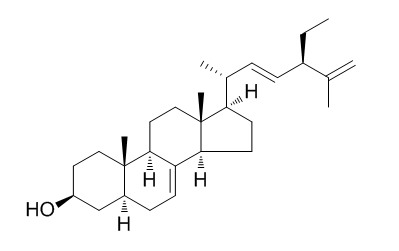7,22,25-Stigmastatrienol
Reference standards.
Inquire / Order:
manager@chemfaces.com
Technical Inquiries:
service@chemfaces.com
Tel:
+86-27-84237783
Fax:
+86-27-84254680
Address:
1 Building, No. 83, CheCheng Rd., Wuhan Economic and Technological Development Zone, Wuhan, Hubei 430056, PRC
Providing storage is as stated on the product vial and the vial is kept tightly sealed, the product can be stored for up to
24 months(2-8C).
Wherever possible, you should prepare and use solutions on the same day. However, if you need to make up stock solutions in advance, we recommend that you store the solution as aliquots in tightly sealed vials at -20C. Generally, these will be useable for up to two weeks. Before use, and prior to opening the vial we recommend that you allow your product to equilibrate to room temperature for at least 1 hour.
Need more advice on solubility, usage and handling? Please email to: service@chemfaces.com
The packaging of the product may have turned upside down during transportation, resulting in the natural compounds adhering to the neck or cap of the vial. take the vial out of its packaging and gently shake to let the compounds fall to the bottom of the vial. for liquid products, centrifuge at 200-500 RPM to gather the liquid at the bottom of the vial. try to avoid loss or contamination during handling.
Biomed Pharmacother.2021, 137:111362.
Horticulture, Environment, and Biotechnology2025, 66:729-739.
Molecules.2021, 26(12):3652.
Molecules.2021, 26(16):4722.
Journal of Oil Palm Research2019, 31(2):238-247
J Food Sci.2024, 3841.17112.
Antibiotics (Basel).2024, 14(1):8.
Brain Res Bull.2024, 218:111103.
Int. J. Mol. Sci.2022, 23(8), 4130.
Saf Health Work.2019, 10(2):196-204
Related and Featured Products
Foods. 2018 Mar 1;7(3). pii: E30.
Chemical and Nutritional Characterization of Seed Oil from Cucurbita maxima L. (var. Berrettina) Pumpkin.[Pubmed:
29494522 ]
Pumpkin (Cucurbita spp.) has received considerable attention in recent years because of the nutritional and health-protective value of seed oil.
METHODS AND RESULTS:
The nutritional composition of pumpkin native to central Italy, locally known as "Berrettina" (Cucurbita maxima L.), was evaluated.
In particular, the lipid fraction of seed oil was characterized, and the triacylglycerol (TAG) was thoroughly studied by using a stereospecific procedure to obtain the intrapositional fatty acid composition of the three sn-positions of the glycerol backbone of TAG. Moreover, alkaline hydrolysis was carried out to study the main components of the unsaponifiable fraction, i.e., sterols and alcohols. It was observed that monounsaturated fatty acids and polyunsaturated fatty acids were the most abundant (41.7% and 37.2%, respectively) in Berrettina pumpkin seed oil, with high content of oleic and linoleic acid (41.4% and 37.0%, respectively). The main sterols of Berrettina pumpkin seed oil were
Δ7,22,25-Stigmastatrienol, Δ7,25-stigmastadienol, and spinasterol; with regard to the alcoholic fraction, triterpenic compounds were more abundant than aliphatic compounds (63.2% vs. 36.8%).
CONCLUSIONS:
The obtained data are useful to evaluate pumpkin seed oil from a nutritional point of view. The oil obtained from the seed could be used as a preservative and as a functional ingredient in different areas, e.g., cosmetics, foods, and nutraceuticals.



